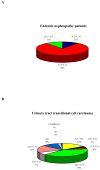p53 mutations as fingerprints for aristolochic acid: an environmental carcinogen in endemic (Balkan) nephropathy
- PMID: 19428366
- PMCID: PMC2729401
- DOI: 10.1016/j.mrfmmm.2009.01.005
p53 mutations as fingerprints for aristolochic acid: an environmental carcinogen in endemic (Balkan) nephropathy
Abstract
The activation of protooncogenes and inactivation of tumor suppressor genes are considered to be the main molecular events in the multistep process of carcinogenesis. Mutations of the TP53 tumor suppressor gene have been found in nearly all tumor types and are estimated to contribute to more than 50% of all cancers. Most mutations lead to the synthesis of highly stable, inactive proteins that accumulate in the nucleus of cancer cells. Among the 393 codons of the human p53 gene, 222 are targets of 698 different types of mutations. Alterations of codons 175, 248, 273 and 282 correspond to 19% of all mutations and are considered general hot spot mutations. Dietary exposure to aristolochic acid (AA), an established nephrotoxin and human carcinogen found in all Aristolochia species was shown to be the causative agent of aristolochic acid nephropathy (previously called Chinese herbs nephropathy). This syndrome is characterized by proximal tubular damage, renal interstitial fibrosis, slow progression to the end stage renal disease and a high prevalence of upper urinary tract urothelial carcinoma (otherwise a highly unusual location). AA preferentially binds to purines in DNA and is associated with a high frequency of A-->T transversions in the p53 gene. Rats treated with AA develop A:T-->T:A mutations in codon 61. The pathological and clinical features of endemic (Balkan) nephropathy closely resemble those associated with aristolochic acid nephropathy except for the slower progression to end stage renal disease and longer cumulative period before the appearance of urothelial cancer. Recently, we reported the presence of AA-DNA adducts in renal cortex and A-->T p53 mutations in tumor tissue of patients from Croatia and Bosnia with endemic nephropathy. These data support the hypothesis that dietary exposure to AA is a major risk factor for endemic (Balkan) nephropathy.
Figures



Similar articles
-
Analysis of TP53 mutation spectra reveals the fingerprint of the potent environmental carcinogen, aristolochic acid.Mutat Res. 2013 Jul-Sep;753(1):41-49. doi: 10.1016/j.mrrev.2013.02.003. Epub 2013 Feb 17. Mutat Res. 2013. PMID: 23422071 Free PMC article. Review.
-
Aristolactam-DNA adducts are a biomarker of environmental exposure to aristolochic acid.Kidney Int. 2012 Mar;81(6):559-67. doi: 10.1038/ki.2011.371. Epub 2011 Nov 9. Kidney Int. 2012. PMID: 22071594 Free PMC article.
-
Balkan Endemic Nephropathy and the Causative Role of Aristolochic Acid.Semin Nephrol. 2019 May;39(3):284-296. doi: 10.1016/j.semnephrol.2019.02.007. Semin Nephrol. 2019. PMID: 31054628 Review.
-
Aristolochic acid and the etiology of endemic (Balkan) nephropathy.Proc Natl Acad Sci U S A. 2007 Jul 17;104(29):12129-34. doi: 10.1073/pnas.0701248104. Epub 2007 Jul 9. Proc Natl Acad Sci U S A. 2007. PMID: 17620607 Free PMC article.
-
Evidence of exposure to aristolochic acid in patients with urothelial cancer from a Balkan endemic nephropathy region of Romania.Environ Mol Mutagen. 2012 Oct;53(8):636-41. doi: 10.1002/em.21732. Epub 2012 Sep 17. Environ Mol Mutagen. 2012. PMID: 22987305
Cited by
-
De novo assembly of a chromosome-level reference genome of the ornamental butterfly Sericinus montelus based on nanopore sequencing and Hi-C analysis.Front Genet. 2023 Mar 8;14:1107353. doi: 10.3389/fgene.2023.1107353. eCollection 2023. Front Genet. 2023. PMID: 36968580 Free PMC article.
-
Aristolochic Acid-Induced Genotoxicity and Toxicogenomic Changes in Rodents.World J Tradit Chin Med. 2020 Jan-Mar;6(1):12-25. doi: 10.4103/wjtcm.wjtcm_33_19. Epub 2020 Mar 13. World J Tradit Chin Med. 2020. PMID: 32258091 Free PMC article.
-
First-line Immune Checkpoint Inhibitor Versus Immune Checkpoint Inhibitor With Chemotherapy for Cisplatin-ineligible Metastatic Urothelial Carcinoma: Evidence From a Real-world, Multicenter Analysis.J Immunother. 2022 Nov-Dec 01;45(9):407-414. doi: 10.1097/CJI.0000000000000441. Epub 2022 Sep 20. J Immunother. 2022. PMID: 36121316 Free PMC article.
-
Upper urothelium carcinomas in Croatian endemic area.Wien Klin Wochenschr. 2013 Sep;125(17-18):529-36. doi: 10.1007/s00508-013-0412-5. Epub 2013 Aug 9. Wien Klin Wochenschr. 2013. PMID: 23928938
-
«Suspects» in etiology of endemic nephropathy: aristolochic acid versus mycotoxins.Toxins (Basel). 2010 Jun;2(6):1414-27. doi: 10.3390/toxins2061414. Epub 2010 Jun 11. Toxins (Basel). 2010. PMID: 22069645 Free PMC article. Review.
References
-
- Yuspa SH, Poirier MC. Chemical carcinogenesis: from animal models to molecular models in one decade. Adv Cancer Res. 1988;50:25–70. - PubMed
-
- Vogelstein B, Kinzler KW. Carcinogens leave fingerprints. Nature. 1992;355:209–210. - PubMed
-
- Greenblatt MS, Bennett WP, Hollstein M, Harris CC. Mutations in the p53 tumor suppressor gene: clues to cancer etiology and molecular pathogenesis. Cancer Res. 1994;54:4855–4878. - PubMed
-
- Hollstein M, Moeckel G, Hergenhahn M, Spiegelhalder B, Keil M, Werle-Schneider G, Bartsch H, Brickmann J. On the origins of tumor mutations in cancer genes: insights from the p53 gene. Mutat Res. 1998;405:145–154. - PubMed
-
- Petitjean A, Mathe E, Kato S, Ishioka C, Tavtigian SV, Hainaut P, Olivier M. Impact of mutant p53 functional properties on TP53 mutation patterns and tumor phenotype: lessons from recent developments in the IARC TP53 database. Hum Mutat. 2007;28:622–629. - PubMed
Publication types
MeSH terms
Substances
Grants and funding
LinkOut - more resources
Full Text Sources
Research Materials
Miscellaneous

